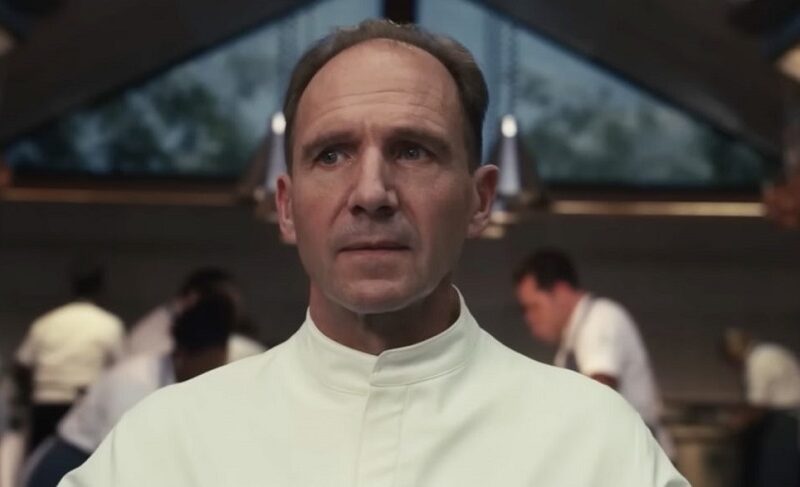The Menu (Mylod, 2022)
The Menu (2022) is a delicious satire about gastriques, desserts, and pretense. Ken wrote a review for another movie about food last week, Kitchen Brigade, and it inspired me to explore Mark Mylod’s more sinister foray into the world of cuisine. In Ken’s review, he highlights how the director of Kitchen Brigade, Louis-Julien Petit, uses food to symbolize an interpersonal binding agent. In that movie, chef Cathy Marie (Audrey Lamy) uses her culinary powers for good and becomes a true asset to her community. It’s a funny and bright film that celebrates the power of food. In The Menu, its chef, Julian Slowik (Ralph Fiennes), does the exact opposite. That makes it a funny, but dark film that forces you to question the ethics that drive the fine dining industry. The similarities between the two movies, and their glaring dichotomy, make the opportunity for comparison too ripe to ignore.
The plot of The Menu revolves around the diabolical mind of chef Slowik and the lavish dinner service that he is providing for 12 overly-esteemed guests at his restaurant, Hawthorne. The essence of the story winds up being a clever commentary on our society’s current obsession with fancy food. The opening scenes of the film are brilliantly pretentious. Food snob Tyler Ledford (Nicholas Hoult) admonishes his date, Margot Mills (Anya Taylor-Joy) for contaminating her palate with a cigarette before they board a yacht that will take them and other guests to Hawthorne. After boarding is complete, they all enjoy a welcome dish of *(checks notes)* “lemon caviar served on raw oyster with mignonette” that would elicit effusive praise from the likes of Gordon Ramsay or Emeril Lagasse. (Even though this scene is meant to be satirical, Mylod stuns you with color and composition and does so throughout the movie in various ways in a display of satirical mastery.) The film’s setup concludes with the arrival of obsequious staff members eschewing their dignity for the sake of customer service. It’s all such a wonderful indictment of privilege and pretense.
And the next 90 minutes don’t let up! In fact, the satire gets delightfully darker than the surface texture of a vanilla crème brûlée. John Leguizamo’s performance as a washed-up Hollywood actor that is constantly at odds with his agent has a real metafictive quality to it. The older couple of means that refuses to enjoy each other’s company in the midst of such luxury and decadence makes little people like me feel much better about not having their money or their access. The pièce de résistance is Mylod’s interpretation of obnoxious finance bros and their petulant need to get what they want when they want it. The film is a masterclass in satire.
And one of the hallmarks of a good satire is the ability to capture the essential elements of the genre it aims to poke fun at, and The Menu does just that. The interstitial scenes that spotlight Slowik’s dishes feel plucked straight from an episode of Top Chef. That show puts food on display like art rather than plain sustenance. And while food can certainly exist as art, food is ultimately nothing more than a fuel source for our bodies. That is a point that Kitchen Brigade tries to make. Shows like Chopped and Hell’s Kitchen give viewers great theater, but they bastardize the purpose of food.
Food is a crucial component of an economy, but it is an even more crucial component of community. The juxtaposition of movies like Kitchen Brigade and The Menu demonstrates that. In Kitchen Brigade, we see how the process of gathering food, preparing it, and consolidating that work into the earnest act of sharing it becomes the ultimate serotonin hack for everyone involved. Diners feel the love cooks pour into the food and servers nobly bridge the logistical gap between the two groups. The Menu shows us what can happen when that process is adulterated by pretense and pomp. Food is supposed to be gratifying on a very simple level, chef Slowik!
And sometimes, even though it’s essential, food falls into the backdrop of the human experience. For example, I had lunch with Ken about a week ago. I had a salad, and he had a bowl of bow-tie pasta. My salad wasn’t gourmet, and his noodles were pretty pedestrian. Slowik would scoff, but Marie would approve. She would approve because the meal brought us together in a moment that was more important than the food. (Shoutout to the Campbell University dining staff though. Y’all do great work, day in and day out!) Cooking shows aren’t going anywhere, nor should they! They’re fun and they give crumb bums like me an opportunity to live vicariously through their escapes. Just make sure you’re taking the time and effort to savor your dining experiences earnestly.

